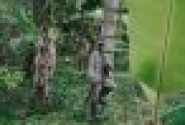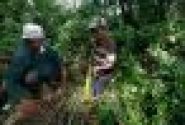
Foresters need to learn to cross research boundaries. Joshua Hilgart-Roy
DOHA, Qatar (5 December, 2012)_A clear trend can be seen at the current U.N. climate change conference, involving agriculture and rural development in the REDD+ debate, crossing sector boundaries and move toward ‘living landscapes’.
Likewise a lot of attention has been given to an integrated landscape approach to climate change mitigation during Forest Day 6. This implies the need for more holistic and interdisciplinary approaches, not only for REDD+ implementation and policies, but also for related research.
Recently, a special issue of Current Opinion in Environmental Sustainability was dedicated to interdisciplinary perspectives on REDD+. It reviewed state-of-the-art REDD+ research from both natural and social science perspectives.
In the introductory article, the authors attempt to address the question ‘Will REDD+ work?’ by differentiating between how, where and when REDD+ might work. Different actors might answer this question differently – as different countries, market actors, civil society groups, local communities and scientist have different views on what REDD+ should be, and what ‘work’ means.
The how, when and where of REDD+ ‘success’ deals with issues of scope, scale and pace. There are two main scope-related issues. First, should REDD+ only focus on reducing carbon emissions or should it focus on biodiversity and social safeguards as well? Second, which forest and land use change activities should be included in REDD+?
Coordination across different scales (local to national), rather than conflict, is an essential factor to making REDD+ work.
And at what pace is REDD+ likely to become a reality? This will depend, to a large extent, on the availability of reliable and sufficient funding for countries to get ‘ready’ for REDD+, as well as on the availability of secure and sustainable payments for carbon credits in the longer term.
So as a PhD student studying REDD+ projects across the world as part of CIFOR’s Global Comparative Study on REDD+, do I think REDD+ will work? From my experience, it will most likely work better in some contexts then in others, so efforts should focus on making REDD+ work as much as possible.
Interdisciplinary research can support our efforts by helping to draw lessons from current REDD+ activities. We, as scientists, have an important role in providing the needed knowledge so different actors involved in REDD+ can deal with the scheme’s complexity.
For photos and videos from Forest Day 6, visit our Flickr page and www.forestday.org/live.
For more stories from the UN climate talks in Doha, click here.
We want you to share Forests News content, which is licensed under Creative Commons Attribution-NonCommercial-ShareAlike 4.0 International (CC BY-NC-SA 4.0). This means you are free to redistribute our material for non-commercial purposes. All we ask is that you give Forests News appropriate credit and link to the original Forests News content, indicate if changes were made, and distribute your contributions under the same Creative Commons license. You must notify Forests News if you repost, reprint or reuse our materials by contacting forestsnews@cifor-icraf.org.











